|
Welcome to the Clean Air Quarterly, the newsletter for port-related clean air and climate solutions. Each edition showcases projects and milestones across our ports and features a partner or member of our team who is making a difference in our region. We also highlight upcoming opportunities for community engagement, like bus tours, commission meetings, and webinars!
This will be our second Year in Review edition, covering our major sustainability successes of 2023 and some exciting projects on the horizon for 2024. The Port of Tacoma, Port of Seattle, and The Northwest Seaport Alliance (NWSA) made major strides towards our ambitious climate goals. From international partnerships, major grant awards, and regional collaborations we are taking measurable actions, as step by step we get closer to our goal of zero emissions by 2050 or sooner. That goal is more attainable with each step we take and we look forward to working with all of you to achieve it. Onward and upward in 2024!
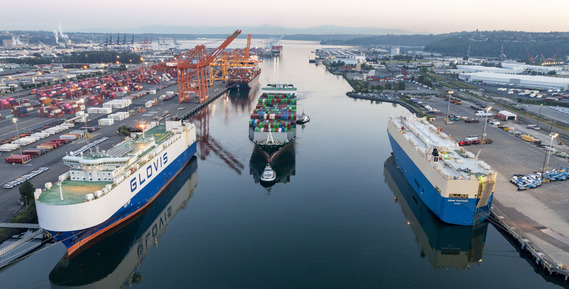 2023 was once again an eventful year for the port’s environmental initiatives. In addition to furthering existing programs and plans, we also took on new opportunities, like our participation in the Hydrogen Hub and continued exploration of Green Corridors, both with cruise and cargo. As we continue to implement our existing body of work, our clean air teams are regularly evaluating new opportunities for engagement.
One overarching change in 2023 was an adjustment to our goal to get to zero emissions by 2050 or sooner. Aligning with the Port of Seattle, the Port of Tacoma voted to advance that timeline to 2040 or sooner for Scope 1 and 2 emissions. NWSA Managing Members voted for the same approach shortly after. All three agencies are now committed to the accelerated timeline for reducing Scope 1 and 2 emissions, the emissions that relate directly to our buildings and infrastructure and how they are powered, ten years sooner than our original goal.
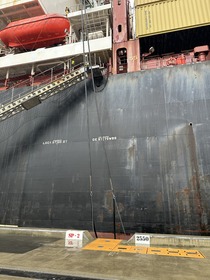
SHORE POWER
When vessels are at dock, a large amount of power is needed to serve on-board functions like lights, climate control, and refrigerated containers. Shore power provides grid energy to these vessels allowing them to shut down their engines. The ports have a goal to make shore power available at all of our major international container and cruise terminals by 2030. To achieve this goal we have a few major projects underway, and each of them hit a new milestone in 2023.
At Terminal 5, not only was the north berth system installed and completed, but we had the first vessel, the MSC Brunella, plug in this year! This made Terminal 5 our first shore power capable international cargo terminal, and the first one of its kind in Washington State. Domestic ships have been plugging in at our TOTE terminal in Tacoma since 2010. The shore power system for the soon to be operational south berth will be online early in 2024.
Husky Terminal also has ongoing shore power work with power systems for both berths under construction and which is expected to come online in 2024.
At their October meeting the NWSA Managing Members voted on the next stage of design for shore power at Terminal 18. Design is underway and we expect to pursue grant funding to support the project in 2024.
For Washington United Terminals preliminary design for a shore power system began this year. This will help us develop the project scope and cost estimate, preparing us to pursue grant funding for the project.
The Pier 66 shore power update spans almost the entire Seattle waterfront! A submarine cable was delivered and construction for the duct bank work both happened at Terminal 46 this year. Next year will see installation of the cable completed and the arrival of a large transformer in spring 2024. Pier 66 will see the first plug in with this system during the 2024 cruise season. Once complete all of the Port of Seattle’s cruise terminals will be shore power capable.
|
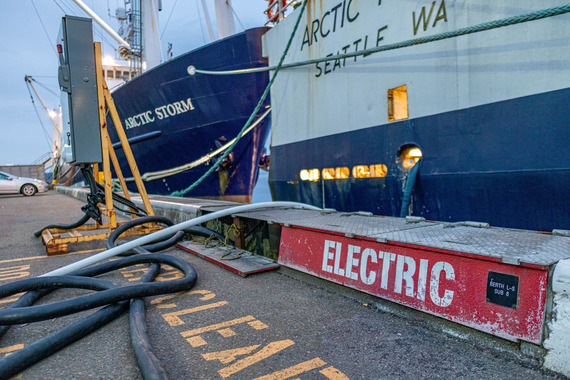 GRANT AWARDS
2023 saw several major grant awards that will support environmental initiatives across our ports. We received the largest Port Infrastructure and Development Program (PIDP) grant of 2023. Husky Terminal was awarded $54 million from the Maritime Administration (MARAD) for terminal expansion and efficiency improvements. This project will reduce emissions by installing additional capacity to plug in refrigerated containers and improving terminal efficiency to reduce idling of trucks and vessels.
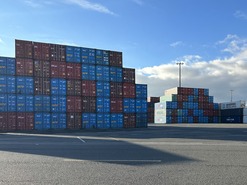
Our ports also received state Climate Commitment Act funding for a couple different crucial projects. In 2023, the state legislature granted $14 million for Terminal 18 shore power and just over $6 million to implement a zero emission truck demonstration program.
Also in the cargo handling equipment space, we received Volkswagen Grant from the Department of Ecology for an electric yard truck and a mobile charging unit at the Port of Tacoma, replacing a diesel yard truck that serves railyard and maintenance operations.
The Port of Seattle completed the successful application and award of $800,000 in funding for the purchase and deployment of all-electric forklifts at Terminal 91.
A robust grant strategy is critically important in being able to accelerate adoption of zero emission technologies at our ports. We will continue to proactively pursue and remain competitive for grant funding at the regional, state and federal level.
|
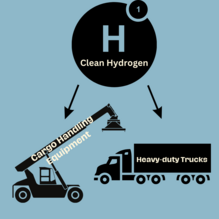
Partnership with other agencies and companies are an integral part of much of the work we do. All our agencies hit major milestones this year by being involved in new partnerships that will lead to significant announcements for many years to come.
A major announcement this year was the $1 billion in federal funding awarded to the Pacific Northwest Hydrogen Hub. Washington and Oregon were selected as one of the six hydrogen hubs in the U.S. for this funding. NWSA is part of the consortium that won this grant and will help align users of clean hydrogen for port applications.
In our 2022 Year in Review both the Port of Seattle and the NWSA announced a partnership to explore Green Corridors for cruise and cargo respectively. These Corridors showcase low and zero-emission life cycle fuels at a scale to be implemented sector wide. The NWSA partnership with South Korea and the Port of Seattle partnership with Alaska both hit new stages this year, with more to come in 2024.
|
FLEETS AND INFRASTRUCTURE
The Port of Tacoma Commission approved the installation of charging infrastructure and broke ground in September on the first EV charging station at the Port Administration Building. The Port installed six charging stations to support its first electric fleet vehicles. They just received four new electric vehicles and are planning to order more later this year.
At the Port of Seattle the transition to zero emission fleet vehicles continues with the introduction of a Ford F-150 Lightning Electric Truck, a Volkswagen ID.4, and a Chevrolet Bolt. The Port has a project underway to install EV charging at its Marine Maintenance facility and is planning to expand EV charging to support fleet electrification across its properties.
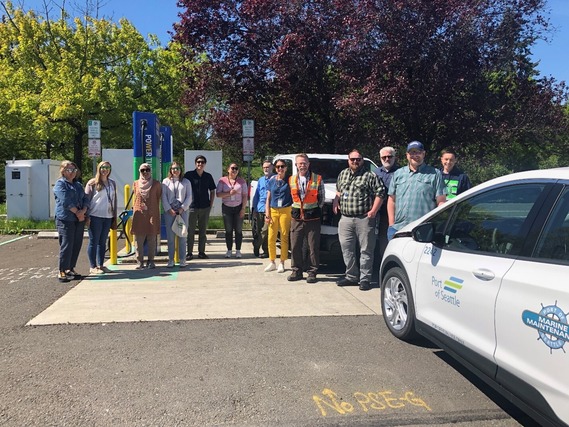 |
Big for 2023 was the launch of the Puget Sound Zero Emission Truck Collaborative ('the Collaborative'). The Collaborative is Washington’s first multi-stakeholder group uniting to accelerate the just and equitable transition to zero emission trucks in Western Washington. It held its first meeting on June 30, 2023 and has established several working groups to approach different parts of the ZE transition, including Funding & Financing; Equity and Infrastructure.

The Collaborative’s work is expected to continue through 2024. Their task to produce a Decarbonizing Drayage Roadmap continues to progress as they collect data and learn from different industry partners. Additional community engagement, including a trucker survey, trucker listening session and community meetings is ongoing through 2024.
Earlier in the year the NWSA also released a Request for Information (RFI) to gather input on the design of the NWSA’s Climate Commitment Act funded zero emission drayage demonstration project. The NWSA is looking to design and launch the demonstration program using this input during 2024, issuing grant funds to incentivize the purchase and operation of zero emission drayage trucks and charging/fueling infrastructure in our gateway.
|
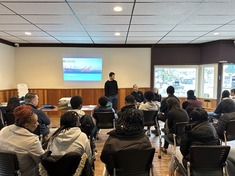
COMMUNITY AND PARTNER ENGAGEMENT
The year started off with the Port of Seattle and NWSA holding the Duwamish Valley Youth Climate Change Adaptation Panel, a panel with youth from the Duwamish Valley focused on how to take action on climate and air issues important to our near port communities.
The NWSA held their fourth North Star Awards, which features two award categories: regional business development and environmental stewardship. This year’s Environmental Stewardship Award went to Rail Management Services for the purchase of six zero emission cargo handling tractors for their rail yard, a major investment in the first zero emission cargo handling equipment in the gateway.
|

RMS provided one of those trucks for Port of Tacoma’s annual Touch-a-Truck event, giving the broader Piece County community the opportunity to engage directly with this type of equipment.
Trucker engagement also continues as we prepare for the zero-emission transition. The NWSA hosted two trucker appreciation events in each harbor, thanking truck drivers for their critical role in our supply chain. These events included a survey to solicit trucker feedback. Responses will provide important and needed data that we will use to help drayage drivers shift towards zero emission while supporting the independent owner/operators and small businesses that make up the majority of this industry.
|
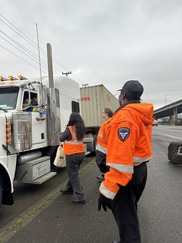
At the end of the year the NWSA and Port of Tacoma had a visit from Governor Jay Inslee to talk about our decarbonization initiatives including our shore power, clean trucks, clean cargo handling equipment, and fleet electrification programs. The Governor toured the Husky shore power and EV charging construction sites and saw electric yard tractors, hybrid RTGs, and electric and hydrogen drayage trucks. Support from our state government is vital to completing our projects, as we collectively build momentum across the state for the type of infrastructure, funding and policy support we will need in the zero-emission transition.
|
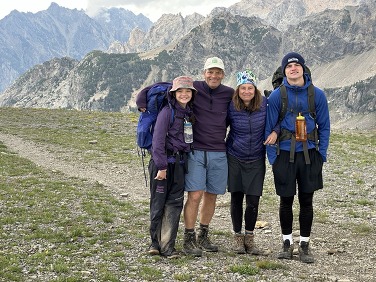
Steve Nicholas is heading into his fifth year as the NWSA and Port of Tacoma's Senior Manager of Air Quality & Sustainable Practices. He is the leader of the Air Quality & Sustainable Practices program and team, which serves both ports. His team leads, facilitates, and coordinates multiple programs, in collaboration with a wide range of partners, all aimed at reducing and eliminating the air and climate pollution associated with seaport activities by 2050 or sooner.
Steve is no stranger to this line of work, having previously served as the founding director of the City of Seattle’s Office of Sustainability & Environment and then as Vice President of US Programs at the Institute for Sustainable Communities, helping cities across the country develop and implement urban climate strategies and solutions. Based on those experiences, Steve co-authored “The Guide to Greening Cities” (Island Press, 2013), which was highly regarded as Steve says, "by the 15 or so people who bought and read it."
“It’s been four years, but I still feel pretty new to the fascinating, challenging, and rewarding realm of TEUs (twenty-foot equivalent units), BCOs (beneficial cargo owners), and RTGs (rubber-tired gantries),” he said. “It’s very exciting to be part of the still-nascent but fast-burgeoning global movement to decarbonize the maritime industry, and I’m very proud to work at a port that’s helping to lead the way.”
Steve grew up in the suburbs of Boston, playing a lot of hockey (street and ice), shoveling a lot of snow, raking a lot of leaves, and getting the occasional sunburn in the bleachers at Fenway Park. He went to college in Waterville, ME (Colby College) and graduate school in Cambridge, MA (Kennedy School of Government), then spent a year in journalism (Ipswich Chronicle) before beginning his career in environmental policy and management at the U.S. Environmental Protection Agency (EPA) – initially at the agency’s headquarters in Washington, DC and then at the Region 10 Office in Seattle. Steve moved to the beautiful Pacific Northwest in 1988, lured by the mountains, Puget Sound, and what was then a relatively laid-back lifestyle. He lives with his wife, kids, and kitties in Ballard.
|
|